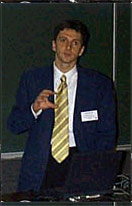| The Industry day was chaired by Sean
Breen of Interactive Multimedia Systems in Dublin
who had a close involvement in many of the CBR applications shown on day 1. [note to myself: how come there's no company like IMS in the UK really pushing these sorts of innovative applications?] |
|
|
| The first presentation of the day was by Mehmet Goker of Daimler Benz
describing a system called Homer that provides tech support to users of Daimler Benz's
CAD/CAM systems. This application involves the support of some 600-1300 CAD clients in a
very dynamic environment. This application is being used a a test-bed for the development
of CBR-Works from tecInno of which we were all to much more about during the workshop. Interestingly Mehmet reported that attempts to build deep model-based and rule-based systems had been tried and had failed. People who attended the conference will know why there is a picture of Homer Simpson here and a link to the official Simpsons site at Fox. Any relationship between Homer Simpson and Homer at Daimler Benz is entirely coincidental. In fact the Daimler Benz system Homer could be named after the classical scholar of that name - Mehmet asked me to make this quite clear to everyone. |
 Mehmet Goker & Homer |
|
| Isabelle
Bichindaritz presented an interesting report on a web-based system that combined CBR
and rules to support clinicians in a cancer practice. Details of the project can be found at the Fred Hutchinson Cancer Research Centre web site. |
|
|
| Jack Sullivan of Tour-IT Ireland is a
business man with a vision. His vision is of thousands of wealthy Americans visiting
Ireland and using a CBR system to plan their vacations. These vacationers he called FIT
(FIT = Free, Independent, Travellers) and they are not interested in standard packaged
tours. His message to the CBR community was to take the time to help business people
understand their own needs and then help them see how CBR can help them. His system was available during workshop for people to plan their excursions into Ireland and can be seen on the web here. |
|
|
| Grayson King of Analog Devices Inc. then showed us (despite having his right arm in a sling - and yes he's right handed) how Analog have been using CBR to help electrical engineers choose the right operational amplifiers (op-amps) for their designs. Grayson explained why conventional database searching and sorting was insufficient to their needs. He then went on to demonstrate the system. A version of this system can be seen on the web here. |
|
|
Belinda Lyons heads Gateway 2000's CBR team in Ireland. Using Inference's CBR3 product they provide support to 600 techs on Gateway's customer support help desk. Belinda described the history of CBR at Gateway (isn't it marvellous that CBR has a history in a company). She explained that Gateway were primarily looking for consistency. Globally Gateway introduces 10-15 new products a week (software & hardware) so providing up to date support is crucial. The deployment of the CBR system on the corporate Intranet was one of the factors that has made the system successful. The system will soon be available to customers on the Internet and a CD containing the CBR system will be shipped with all new PCs. |
|
|
| Karl-Hienz Busch of Siemens AG described
another tech support CBR system that uses a tool called CBR-Answers. This tool is sort of
an intelligent FAQ system. He provided an excellent description of the processes by which
the tool was developed and is maintained. He also provides some details of comparative evaluations of CBR-Answers with Inference's CBR3 product.
CBR-Answers is so much more efficient because it selects the best matching case using only a textual query, whereas CBR3 is more iterative using text and then questions to focus the search. Siemens are expecting savings of DM 1.74 million by the year 2000. The system has been live on the Internet for 4 months and can be seen here. |
|
|
| John Donovan of the Irish Research Scientists Association described a system that uses CBR to search the Irish National Expertise Register. The system uses profile matching (it's a bit like a dating service) that lets you enter the sort of expert you're looking for and then returns the closest matching people. Of interest is the way the system never fails to return anyone (like a database might) and that case features can evolve dynamically. |
|
|
| The final presentation of the day was by Patrick Renoux describing a failed attempt at Caledonian Paper to predict faults in a paper mill. Personally I had some problems with this presentation but not because it presented results from a system that failed. This should be encouraged as we can all learn from failure. Basically, the presentation and the paper described an attempt to use an inductive learning algorithm to successfully classify signal data. They used the now defunct tool ReMind from Cognitive Systems and lets face it this tool never did use a state-of-the-art induction algorithm. Moreover, as several people in the audience pointed out, some possibly important predictive features were not available to the induction algorithm so it is no surprise it was not able to predict failure reliably. This was not really CBR it's ML and it was very unlikely to ever have succeeded. |
|